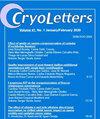Cryopreservation of organoids.
IF 1
4区 生物学
Q3 BIOLOGY
引用次数: 0
Abstract
Organoids represent indispensable opportunities for biomedicine, including drug discovery, cancer biology, regenerative and personalised medicine or tissue and organ transplantation. However, the lack of optimized preservation strategies limits the wide use of organoids in research or clinical fields. In this review, we present a short outline of the recent developments in organoid research and current cryopreservation strategies for organoid systems. While both vitrification and slow controlled freezing have been utilized for the cryopreservation of organoid structures or their precursor components, the controlled-rate slow freezing under protection of Me2SO remains the most common approach. The application of appropriate pre- or post-treatment strategies, like the addition of Rho-kinase or myosin inhibitors into cell culture or cryopreservation medium, can increase the recovery of complex organoid constructs post-thaw. However, the high complexity of the organoid structure and heterogeneity of cellular composition bring challenges associated with cryoprotectant distribution, distinct response of cells to the solution and freezing-induced injuries. The deficit of adequate quality control methods, which may ensure the assessment of organoid recovery in due term without prolonged re-cultivation process, represents another challenge limiting the reproducibility of current cryobanking technology. In this review, we attempt to assess the current demands and achievements in organoid cryopreservation and highlight the key questions to focus on during the development of organoid preservation technologies. Doi: 10.54680/fr23210110112.类器官的低温保存。
类器官代表了生物医学不可缺少的机会,包括药物发现、癌症生物学、再生和个性化医学或组织和器官移植。然而,缺乏优化的保存策略限制了类器官在研究和临床领域的广泛应用。在这篇综述中,我们简要介绍了类器官研究的最新进展和目前类器官系统的冷冻保存策略。虽然玻璃化冷冻和慢速控制冷冻都被用于类器官结构或其前体成分的低温保存,但在Me2SO的保护下控制速率慢速冷冻仍然是最常用的方法。应用适当的预处理或后处理策略,如在细胞培养或冷冻保存培养基中添加rho激酶或肌球蛋白抑制剂,可以增加解冻后复杂类器官构建物的恢复。然而,类器官结构的高度复杂性和细胞组成的异质性带来了与冷冻保护剂分布、细胞对溶液的不同反应和冷冻诱导损伤相关的挑战。缺乏足够的质量控制方法,以确保在适当的时间内评估类器官的恢复,而不需要长时间的重新培养过程,这是限制当前冷冻银行技术可重复性的另一个挑战。本文综述了目前类器官冷冻保存技术的研究现状和取得的进展,并提出了类器官冷冻保存技术发展中需要关注的关键问题。Doi: 10.54680 / fr23210110112。
本文章由计算机程序翻译,如有差异,请以英文原文为准。
求助全文
约1分钟内获得全文
求助全文
来源期刊

Cryo letters
生物-生理学
CiteScore
1.80
自引率
10.00%
发文量
50
审稿时长
1 months
期刊介绍:
A bimonthly international journal for low temperature sciences, including cryobiology, cryopreservation or vitrification of cells and tissues, chemical and physical aspects of freezing and drying, and studies involving ecology of cold environments, and cold adaptation
The journal publishes original research reports, authoritative reviews, technical developments and commissioned book reviews of studies of the effects produced by low temperatures on a wide variety of scientific and technical processes, or those involving low temperature techniques in the investigation of physical, chemical, biological and ecological problems.
 求助内容:
求助内容: 应助结果提醒方式:
应助结果提醒方式:


